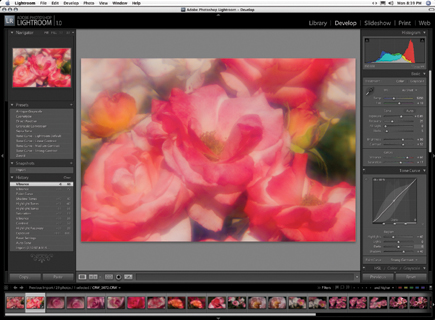Adobe’s Photoshop Lightroom 1.0; Should Photo Enthusiasts Embrace Adobe’s Lightroom? Page 2
 |
|
|
Generally, the beta process confirmed from my perspective that Lightroom is
seen by many professionals as a "bottom line" type software; that
is, one where efficiency, and not elaboration, is of the greatest benefit. Lightroom
is a recognition that for most professionals time spent using it is not "billable"
time but an overhead cost. It also seems to confirm the end of a trend that
started with early adopters of digital photography--clients asking photographers
to provide press-ready submissions. The very high wall that historically existed
between photography and press functions apparently has not been brought down
by digital convergence; indeed, many clients no longer expect to get pre-press
done on the cheap as part of what photographers submit. In my opinion it is
just not a practical or a viable solution to expect professional photographers
to provide pre-press services. This is reflected in the rather limited output
options Lightroom provides, and which are divided into three categories: Print,
Slideshow, and Web.
Evaluation And Recommendation
Lightroom has evolved into an effective, targeted tool primarily for professionals.
It functionally falls between Elements and Photoshop/Bridge but with a more
particular purpose and function that, although not restricted to digital camera
raw files, does not really compete with what either Elements or Photoshop provides.
Many photographers may very well be fully served in all their image processing
and editing needs by Lightroom simply because they don't have a need for
the tools and processes that are included in a comprehensive image editor and
creative application like either Photoshop or Elements. And although the beta
process seemed to indicate the target user of Lightroom is likely to be a professional
photographer, many advanced photo enthusiasts actually do photography in a way
that parallels how the pros work, so Lightroom should be taken seriously by
any active photo enthusiast. This is especially true for those who shoot primarily
in raw format and produce sizeable numbers of exposures in one project or session.
 |
|
|
Unlike starting from scratch with Photoshop, Lightroom is much easier to learn
and you can get up to speed quite quickly. It certainly provides a much more
efficient workflow. I almost hate to say it but it is what people call a "no-brainer."
That is, unless you are an Apple Mac computer user and then you have the very
similar Apple Aperture, now in Version 1.5.2 (see my report that also appears
in this issue). In the first quarter of its release a Lightroom purchase involves
a $100 discount: the list price of Adobe's Lightroom is $299.
For more information, contact Adobe Systems Inc., 345 Park Ave., San Jose, CA
95110; (800) 492-3623, (408) 536-6000; www.adobe.com.
- Log in or register to post comments

































